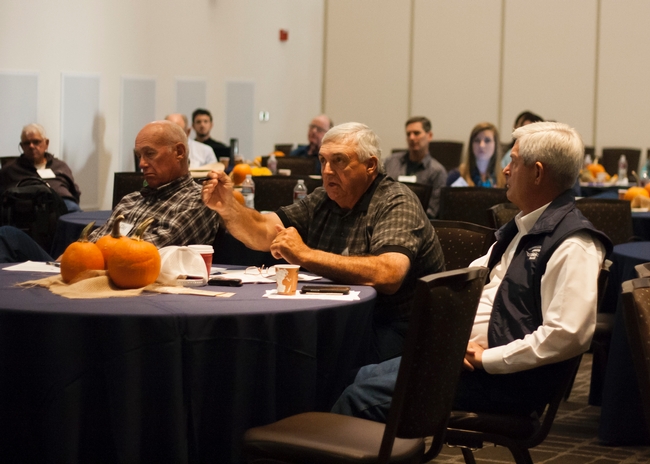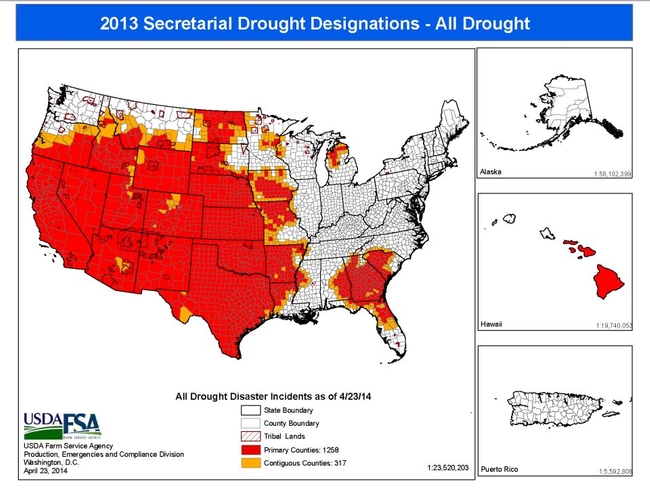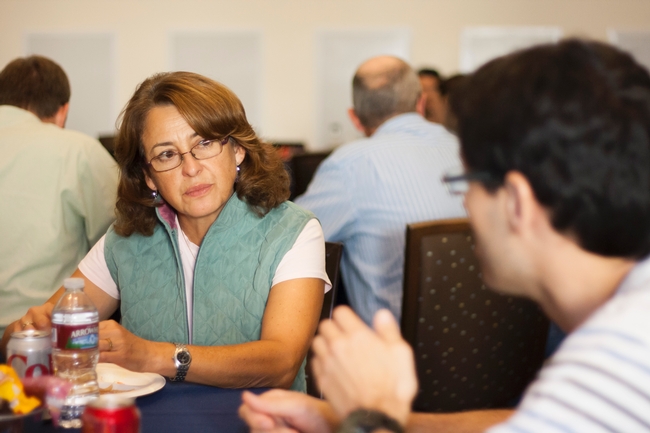
Posts Tagged: California drought
International and California water conferences shine new light on lingering drought
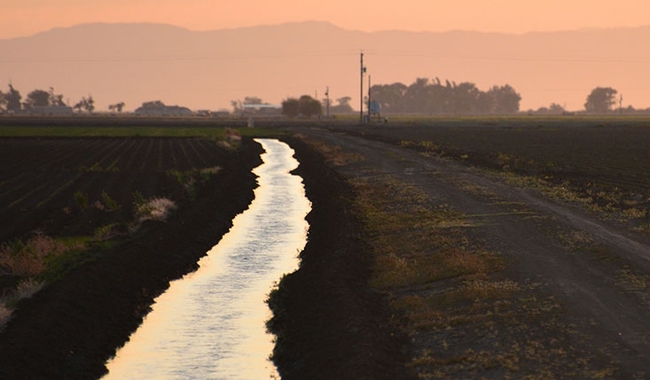
The total cost to the state, according to a new report released Tuesday by the Center for Watershed Sciences (CWS) at the University of California, Davis, is now $2.74 billion and 21,000 jobs.
Some see this as the new normal and new evidence ties it to climate change.
But despite the profound impact on the California agricultural economy, the state is actually doing well. And it's becoming the world's test kitchen for best practices in adapting agriculture to changing water supplies.
A legacy of progressive environmental regulations
“Despite the drought, we have a remarkably robust agricultural system,” says Jay Lund, director of CWS. “If you go back millennia and look at droughts, with a 30 percent loss of water you'd have a 30 percent loss of food production and you'd have 30 percent of the people starving.”
That hasn't happened today, he says, because California agriculture is more diversified than ever and its economy is connected to a world food market that advances despite the drought.
The many tools that UC Agriculture and Natural Resources (UC ANR) and others are deploying to help Californians better adapt today are also being translated into immediate lessons for the developing world.
Stockholm comes to Davis
Starting Sunday, representatives from more than 200 organizations will meet in Stockholm, Sweden, for the World Water Week mega conference. Under the theme Water for Development, they will refine the United Nations' broad Sustainable Development Goals to address the one billion people who would still be without safe drinking water and basic sanitation.
Many partners of UC ANR and the UC Davis World Food Center will be leading some of the numerous discussions, including: CGIAR, the World Bank, the Bill & Melinda Gates Foundation and the UN Food and Agriculture Organization.
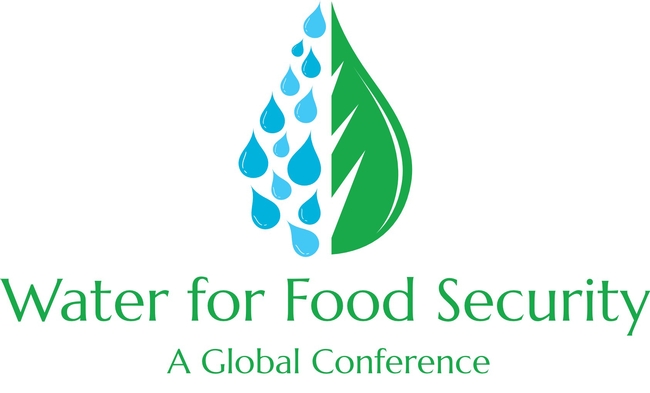
Presentations on the Case of California will open two days of panel discussions, ranging from how climate change will impact the cost of water in different regions of the world to how groundwater aquifers can be recharged and how new policies can bolster water markets.
The goal is to seize the momentum now building for an international effort towards #WaterSecurity. By drawing development investors, leading scientists, committed policy makers and global industry partners into one room within the world's number one ag school, the event will set a course of action in sustainably securing water for food and for people across the planet.
What's That Wet Stuff?
What's that wet stuff falling from California skies? Could it be the "R" word, rain? Or what Wikipedia calls "liquid water in the form of droplets that have condensed from atmospheric water vapor and then precipitated—that is, become heavy enough to fall under gravity?"It is. A...
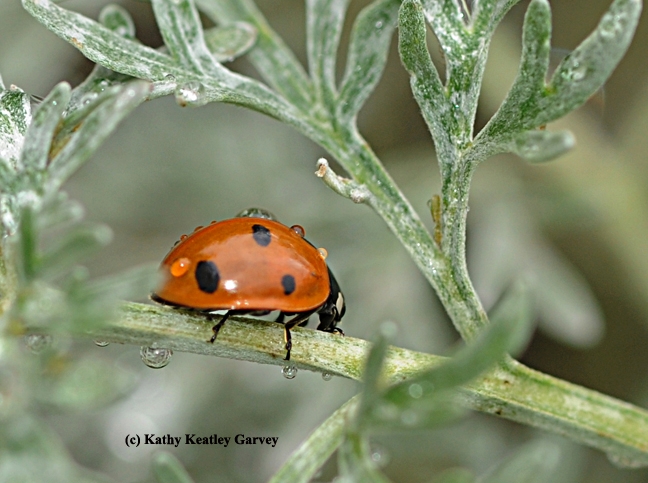
Rain drops falling on a lady beetle, aka ladybug. (Photo by Kathy Keatley Garvey)
Drought talk draws ranchers, researchers and climatologists
California's severe drought is entering a fourth year. With that, scientists met with ranchers to give background and gain feedback on a key climate indicator: the U.S. Drought Monitor.
The November 7 workshop held at the University of California, Davis, and webcast to 15 satellite locations across the state posed questions to a panel of experts who help publish the weekly analysis. UC Davis researchers also discussed new findings from in-depth rancher interviews along with strategies for maintaining the nutrition of cattle during the water shortage.
Read the full article at the UC Davis Department of Plant Sciences.
“We learn a lot when times are tough,” said Rick Roberti, a cattle and hay rancher who attended the workshop. “We're never going to have the water we need. So we might as well learn now how to deal with it.”
In 2012, the second year of California's drought, more than 2,500 of the nation's 3,000 counties qualified for disaster loans, due to designations made through the Drought Monitor.
"You see the grass that we had then and the grass that we have now and it's nothing to compare to," says rancher Antonia Suenz of Marysville, California. "The climate is changing."
California state climatologist Mike Anderson showed that only 1924 saw less rain than this year, but 2014 has had far higher temperatures: “So not only are you dealing with lack of water, you're dealing with Mother Nature increasing the demand for what water you have.”
Listen to more of this conversation with Anderson at California Drought Watch.
Ranching and California's drought: A workshop & webcast

These concerns and more are being discussed at an upcoming meeting called “Ranching and California's Drought” a public workshop and webinar to be held on the UC Davis campus Nov. 7 and broadcast at local satellite locations throughout the state.
Drought experts from a range of organizations will open the dialogue with ranchers, to discuss the science and the policies of how drought is declared and mapped in California. UC Davis researcher Leslie Roche will present new insights from an extensive study, having surveyed and interviewed ranchers throughout the state. Other topics include new feeding strategies, how ranchers can qualify for drought relief assistance and a seasonal forecast from the state climatologist. The workshop will be a learning opportunity for researchers as well.
“There are impacts of drought on a ranch that these models are blind to or just can't integrate,” says UC Davis Cooperative Extension specialist Ken Tate, one of the meeting organizers. “But these things need to be integrated into policy.”
As an example, he explains how late April showers in northern California gave this year's totals a deceptively positive review: “It may not look like that big of a drought on the annual forage production basis, when in reality it was horrendous in December and January,” he says. “April rain and forage were too late to save the day.”
The forum will allow Drought Monitor experts to better integrate local knowledge into their analysis and decision making, Tate says, adding: “They're really open and really interested in having these conversations.”

Ranching and California’s Drought: workshop and webcast, November 7, 2014
November 7, 2014
• What the U.S. Drought Monitor means to you
• How CA Ranchers are coping with the drought
• New feeding strategies for livestock in drought
• NOAA's forecast for the coming season
The map tells the tale of California's relentless drought, its location and severity. This workshop will tell you the story of the Drought Monitor, in particular how the map may help you qualify for drought relief assistance – and how local California experience and information can be used to inform the drought mapping process. Results will also be shared from current studies of how ranchers are impacted by and managing for drought on their ranches, as well as on the newest livestock drought feeding strategies. The California state climatologist will present the forecast for the coming season. The workshop will be on the UC Davis campus and webcast to the majority of participants at local satellite locations across California. The workshop recordings will be posted on-line.
Questions and comments from local satellite webcast locations will be included throughout the workshop.
Agenda
| 9:15 AM | Registration Opens and Morning Refreshments Served | |
| 9:50 AM | Welcome, Ken Tate, UC Davis and UC Cooperative Extension | |
| 10:00 AM | U.S. Drought Monitor: Setting the Context and Introduction of Speakers, Mark Svoboda, National Drought Mitigation Center | |
| • A Behind the Scenes Look at the Drought Monitor: History, Tools, and Methods, Eric Luebehusen, USDA | ||
| • How to get information into the US Drought Monitor Process, Brian Fuchs, National Drought Mitigation Center | ||
| • The California Drought of 2011-14: Brief History and Current Impacts, Brad Rippey, USDA | ||
| 11:00 AM | Questions and Discussion about the Drought Monitor and California, Chad McNutt, NOAA Discuss the Drought Monitor and how California's ranching and range community can inform the process. |
|
| 12:00 PM | Lunch Provided by the UCD Rustici Rangeland Endowments | |
| 1:00 PM | California Ranchers' Experiences with Drought, Leslie Roche, UC Davis Insights to on-ranch drought impacts, outlooks, and management based on surveys and interviews of over 500 ranchers living through this drought. |
|
| 1:30 PM | New Livestock Drought Feeding Strategies, Glenn Nader, UC Cooperative Extension Tips for improving the nutritional quality of low quality feed products, and supplementing livestock diets on rangelands. |
|
| 2:00 PM | Seasonal Climate Forecast and Opportunity for Q&A's for the Coming Season, Michael Anderson, California State Climatologist, California Department of Water Resources | |
| 2:30 PM | Closing Remarks, Tim Koopmann, President, California Cattlemen's Association |
Contact for Information and Registration – Tracy Schohr at tkschohr@ucdavis.edu or (916)716-2643(916)716-2643
Workshop and Webcast Locations – UC Davis campus and webcast to Auburn, Ventura, San Luis Obispo, Bakersfield, Tulare, Merced, Ukiah, Redding, Susanville, Yreka – more locations and details coming soon.
Useful Links
U.S. Drought Monitor – http://droughtmonitor.unl.edu/
U.S. Drought Monitor California– http://droughtmonitor.unl.edu/CA
UC Rangeland Watershed Laboratory Drought Page – http://rangelandwatersheds.ucdavis.edu/main/drought.html



